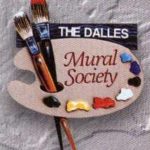 The Dalles Murals are a collaborative effort committed to bringing artists and beautiful artwork depicting area history, using our downtown buildings as the canvas. These famous moments in history have been magnificently illustrated by renowned northwest artists.
The Dalles Murals are a collaborative effort committed to bringing artists and beautiful artwork depicting area history, using our downtown buildings as the canvas. These famous moments in history have been magnificently illustrated by renowned northwest artists.
The murals welcome visitors and tourists, including the tour boat visitors who stroll into the downtown area via the Union Street overpass that leads to the Columbia River. The underpass project restored access to the river from the historic downtown business district of The Dalles and was completed in September of 2003.
The mural walk becomes truly a cultural and educational experience for all ages. Every mural features a legend which tells the story of its illustrated historic event. The Dalles, Oregon has a rich cultural history. You will find murals honoring the original Native Americans who have lived in this area for over 10,000 years, the Lewis and Clark Expedition which passed through The Dalles during their historic journey from St. Louis to the Pacific Ocean, and murals honoring the pioneers who forged a new life here at the end of The Oregon Trail.

Map of The Dalles Murals
Take a tour of Downtown The Dalles and visit each one of the Talking Murals. Famous moments in history magnificently illustrated by renown northwest artists are located through out The Dalles. A cultural and educational experience for all ages. Keys to the Talking Murals boxes are available at The Dalles Chamber of Commerce. (Note: not all murals are shown on the map, but you’ll find street addresses listed with the photo and descriptions below.)
Mural #1, “Decision at The Dalles”
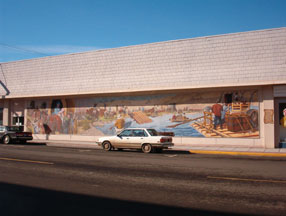
After arriving at The Dalles, the Oregon Trail emigrants faced one final hurdle before reaching the promised land. The final and most perilous decision, rafting the torrid rapids of the Columbia River or facing the incredibly dangerous landscapes of the Barlow Road. This mural is dedicated to the purpose and spirit of the Great Emigration.
Artist: Don Crook
Painted: 1992
Location: Downtown, E. Federal Street between 2nd and 3rd St.
Mural #2, “Lewis and Clark at Rock Fort”
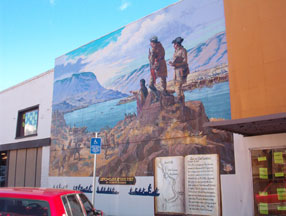
Rock Fort is an important Mid Columbia Campsite of the Lewis and Clark Expedition. After Portage around the Great Falls (Celilo) they came to a gentle part of the river near the present city of The Dalles. They formed their camp on a high point of rocks, which forms “A kind of fortification well calculated for defense.” Here the expedition remained October 25, 26 and 27, 1805 while they dried supplies, repaired canoes, hunted and reconnoitered the river below. They returned to camp here again on their return jouney on April 15, 1806 to (Lewis wrote) “The place we called Rock Fort Camp.”
Artist: Robert Thomas
Painted: 1993
Location: Downtown, E. Federal Street SW corner of 1st and 2nd.
Mural #3, “The Dalles, Northwest Trading Center for 10,000 Years”
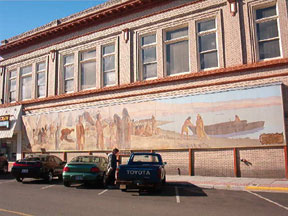
A step back in time and history. For more than 10,000 years, The Dalles has been one of the areas along the Columbia River that supported flourishing civilizations. Ancestors of today’s Yakama, Warm Springs, Umatilla and Nez Perce tribal nations lived and fished along the river’s banks, trading their dried smoked salmon with indians who came from all over the western part of North America as well as Mexico and the Southwest.
Artist: Roger Cooke
Painted: Date not listed
Location: Downtown, E. Federal Street on the NW corner of 1st and 2nd.
Mural #4, “Celilo/Wyam – The Great Falls on the Columbia”

Ancient fishing ground, Celilo Falls/Wyam Falls. The historic fishing, trading and gathering place of many tribes from time immemorial until inundated by rising waters of Lake Celilo in March 1957.
Artist: Robert Thomas
Painted: 1994
Location: Downtown, E. Federal Street on the SE corner of 2nd & 3rd.
Mural #5, “Where Wheat is King”
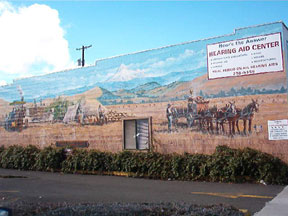
As you travel South and East of The Dalles you will be traveling through the beautiful rolling hills of one of our nations major wheat producing areas. Our forefathers built an empire with wheat as the cornerstone. This turn of the century harvest scene comes to life once a year, the second weekend in August at the historic farming community or Dufur, Oregon during the annual Threshing Bee.
Artist: Robert Thomas
Painted: 1995
Location: Downtown, 2nd Street, on the building occupied by Zim’s Tavern and Hears The Answer Hearing Aid Center.
Mural #6, “Hudson Bay Company”

The British owned Hudson Bay Company dominated the fur trade in the Pacific Northwest during the early 1800’s. Dr. John McLaughlin, who headed the Northwest enterprise, sent brigades of boats far up the Columbia River to far flung Company forts, bringing loads of supplies and returning with a bounty of furs. During the years 1824 to 1846, the brigades would ply their trade at The Dalles, an historic Indian trading site, purchasing the coveted beaver pelts for such items in trade as blankets, tobacco and pipes, knives, traps, beads, powder and balls.
Artist: Roger Cooke
Painted: 1995
Location: Downtown, E. 2nd Street near JD Smith Jewelers
Mural #7, “Peace Treaty of 1855” (mural no longer exists)
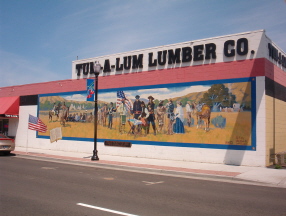
This mural, sadly, no longer exists. It had badly deteriorated, and when The Dalles Chronicle relocated to this building in 2018 it was painted over. However, it is on the original mural map, so as a memorial to this work of art, we are leaving it on the list. The history behind this scene was: As a result of the great western migration in the mid-1800’s, the Indians and the White Man found that they could not live together in peace. So it came to pass on June 25, 1855 that General Joel Palmer, Superintendant of Indian Affairs in the Oregon Territory signed a treaty with the Wasco, Upper and Lower Deschutes, John Day River and Dog Rover Indians (Hood River) at the crossing on Three Mile Creek just south of The Dalles. The treaty provided the 1,400 (approx.) Indians be placed on the 11,000 square mile Warm Springs Reservation, in present day S.W. Wasco and N.W. Jefferson Counties. In return, the Indians ceded all their lands to the United States Government for $150,000 to be paid over Twenty years. Further, The U.S. Government agrees to provide a sawmill, flourmill, plow shop, schoolhouse and hospital plus other facilities to help the Indians adjust to reservation life. White people were also assigned to instruct them in their use. Today, the Confederated Tribes of the Warm Springs Reservation are a valued part of our community and their world class museum warmly welcomes visitors from all over the world.
Artist: R.E. Pierce and Don Prechtel
Painted: 1996, painted over 2018
Location: Downtown, E. 2nd Street between Monroe and Taylor.
Mural #8, “Umatilla House: 1857-1930”

When the Umatilla House was completed in 1857, it soon became nationally known for its architectural charm, lavish furnishing and fixtures and warm and gracious hospitality. This stately property was considered to be the finest hotel west of Chicago and north of San Francisco. Further, it became the meeting place for steamboat men, miners, sheep and cattlemen, freighters and the citizens of The Dalles. The barroom was elaborately decorated and often stocked as much as 2,500 gallons of whiskey and was the scene of many high stakes card games.
The main dining room seated 250 persons and employed as many as 16 waiters and 12 cooks. This was backed by an abundantly stocked storeroom that held hundreds of dozens of eggs. Beef and ham were purchased by the ton, while a number of farmers sold their entire crop of garden produce to the hotel. Considering the luxurious furnishings, outstanding service and quality food and drink, it is no wonder that the Umatilla House was the center of Mid-Columbia affairs.
During its long and illustrious life, the hotel played host to many distinguished guests. Some of them were the likes of: U.S. President Ulysses S. Grant, General W.T. Shermon, Railroad Tycoon Henry Villard, Author Charles F. Train, Mr. and Mrs. Thomas A. Edison, England’s Lord Litchfield, Author Rudyard Kipling, Boxers John L. Sullivan and James Corbett, U.S. Vice President Schuyler Colfax, Author and Humorist Mark Twain and U.S. Senators J.N. Dalph and J.S. Mitchell.
The hotel had several owners that included H.P. Isaac’s who sold the property in 1883 to N.B. Sinnott and Major Dennis Hardley. They sold an interest to Judd S. Fish in1893 and he sold to H.B. Salisbury in 1897.
The life of the Umatilla House was not always a scene of fine dinning and gracious living. It suffered several tragic events that included two devastating fires: each time it burned to the ground. On both occasions it was rebuilt only to be damaged by the destructive flood of 1894. The once proud hotel fell into disrepair during the early 1900’s and was ordered destroyed by owner H.B. Salisbury on June 30, 1930.
Artist: Robert Thomas and Debbi Lunz
Painted: 1997
Location: Downtown, West 2nd Street, on the The Dalles Inn hotel building.
Mural #9, “Old Wasco County: 1854-1859”
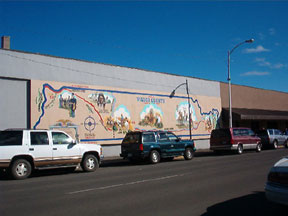
The Territorial Legislature created Wasco County on January 11, 1854. Old Wasco County covered 130,000 square miles, extending in a swath from the crest of the Cascade Mountains to the Continental Divide atop the Rockies. This made it the largest organized county in U.S. History. It occupied a sizable part of Oregon Territory until 1859 when Oregon achieved statehood.
Artist: Jim Weeks
Painted: Date not listed
Location: Downtown, E. 3rd Street, between Washington and Federal Streets. As of January 2020, this property is for sale and if it is remodeled the mural may be relocated or replaced.
Mural #10, “Rock of Ages” (Pulpit Rock)

The Methodist Church in 1833 appointed Reverent Jason Lee, his nephew Reverend Daniel Lee and Reverend Henry K.W. Perkins to the new Methodist Episcopal Mission that was to be established at The Dalles in 1838. Reverend Perkins describes his mission as the “Wonderful Work of God.”
The Wascopam Methodist mission included preaching, prayer, teaching, translation, conversion, baptism, visitation and Christian comfort in the ever changing and challenging lands of the new territories. During the period between 1838 and 1848, the area north of Pulpit Rock, at Amotan Springs (now on the grounds of The Dalles Wahtonkia High School) became the primary meeting and preaching location in the area.
Pulpit Rock still stands today. To visit this rock monument, starting from 1st and Union – go up the hill (headed south on Union Street) to East 12th. Turn left (east) on 12th and go one block to Court Street. The rock is located just south of The Dalles Wahtonka High School.
Artist: Hulan Fleming, assisted by Gary Bright
Painted: June 1999
Location: Downtown, E. 3rd Street, on the Salvation Army building.
Mural #11, “Corps of Discovery: Into the Narrows”
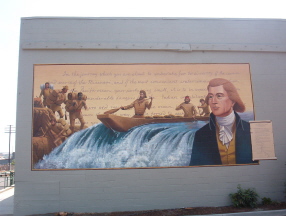
President Thomas Jefferson’s vision to reach the Pacific Ocean overland was about to be realized in less than 200 miles but first the Corps had to shoot the rapids of the Narrows at the Columbia. The important supplies were portaged and the swimming members of the party boarded the canoes and cast off.
The Short Narrows were where the Columbia River constricted to only 45 yards wide and a quarter of a mile long and the Long Narrows were 100 yards wide and three miles long. Captain William Clark wrote: “… the horrid appearance of the agitated, gut swelling water was boiling and whorling in every direction…”
In the standards of today’s canoeists, this was a Class V rapid (on a scale of 1-6). Luckily, the Corps with their five heavy dugout canoes made the run without incident.
Artist: Gary Kerby
Painted: 2003
Location: Downtown, E. Federal Street, 1st Street between Federal and Laughlin, facing The Dalles Veterans Center.
Mural #12, “Sahaptin Medicine Man”
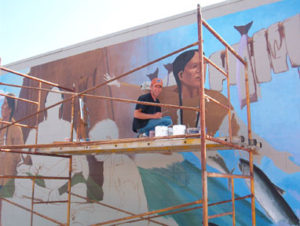
This mural depicts the wisdom and mystery of the Native American Medicine Man. An integral part of Native American culture, the Medicine Man walked the path between the spirit world and ordinary reality. In the days before white settlers, the medicine man of the Sahaptin speaking people of the Wyam area (Celilo Falls) had great powers and lived away from other tribal members. His duties consisted of all things of the body and spirit as well as being a voice of the land to bring the renewal of abundance to the natural world, especially the seasonal return of the spawning salmon, the nusook.
Artist: Gary Kerby
Painted: June, 2003
Location: Downtown, 1st and Union St.
History of the Murals
For many years The Dalles Mural Society was headed up by an energetic and visionary local businessman and entrepreneur, Gary Honald. Honald once owned a sign and billboard company and had the expertise of how to create large-scale art. The vision was to make the murals themselves worthy of becoming a tourist destination, to bring in visitors to The Dalles to see the art. But when Honald died unexpectedly on May 30, 2015, his absence left a big gap. The remaining members of the Mural Society, left without their leader, didn’t have the expertise or the financial resources to maintain the current murals, much less bring in new ones.
The murals languished as time, weather, and age began to chip away at the murals. One of them, depicting the signing of the 1855 peace treaty, became so damaged that the new building owner saw no recourse but to paint over it.
Another mural, the one depicting Lewis and Clark at Rock Fort Camp was threatened with demolition when a developer wanted to turn the building into a glass fronted condo complex. The citizens of The Dalles objected and eventually the project was abandoned, leaving an empty building and no plans for the future.
The Dalles Mural Society had dwindled, most of its members being elderly volunteers. A small group of downtown business owners stepped in, with hopes of restoring the aging murals.

Enter Main Street. The organization was intended to help small towns revitalize their downtown areas.
New mural artists were brought in, including Toma Villa, a young man with strong cultural ties to the area Indigenous people. Villa painted a new mural on a downtown building, as well as one on the side of the Next Door, a building that houses the non-profit that assists foster kids and others.

Now there are plans in the works to bring in the WallDogs, who are committed to making our town a wonder of wall art. Stay tuned to see further developments.